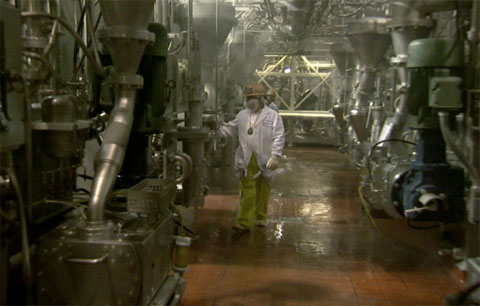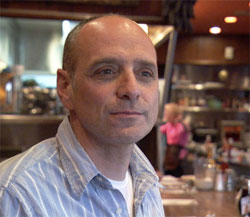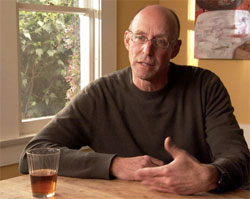Food, Inc.: What the food industry doesn’t want you to see
By James Brewer
3 September 2010
 Food, Inc.
Food, Inc.In light of the recent outbreaks of salmonella in the US, it is worth reviewing Food, Inc., the recent film exposé of the food industry. The documentary, directed by Robert Kenner, was first released to theaters in the US in 2009, and on DVD in 2010. Despite a failure to draw any sharp political conclusions, the film is a damning indictment of the inability of the profit system to provide safe and healthy food for the vast majority of the populace.
Whatever you may think of the corporate food industry, Food, Inc., will show you, disturbingly, that the situation is worse than you think.
Produced and directed by television documentary filmmaker Kenner (PBS series, The American Experience, Two Days in October), it draws heavily on input by co-producer Eric Schlosser (Fast Food Nation) and Michael Pollan (Omnivore’s Dilemma, Food Rules, An Eaters’ Manual and In Defense of Food: An Eaters’ Manifesto), both top-notch investigative journalists in the food industry.
One of the guiding ideas of Food, Inc., is that the reality behind food production in the US does not jibe with the pastoral imagery often depicted on the packaging, but rather involves giant firms operating huge factories with brutal conditions.
Food, Inc., traces the origins of modern-day food production—perhaps a bit simplistically—to the fast food industry, particularly McDonald’s. To make their business even more successful, the McDonald brothers cut most of their menu and limited it to a few key items that could be produced in mass quantities. Workers were trained to do only one thing, so they could be paid cheaply and easily replaced. Since then, McDonalds’ success has made them the single largest purchaser of beef in the world, and their demand for uniformity has changed the entire beef producing industry.
 Eric Schlosser
Eric SchlosserEric Schlosser introduces the film: “The way we eat has changed more in the last 50 years than in the previous 10,000…. Now our food is coming from enormous assembly lines where the animals and the workers are being abused, and the food has become much more dangerous in ways that are deliberately hidden from us. This isn’t just about what we’re eating. It’s about what we’re allowed to say. What we’re allowed to know.”
Schlosser further points out that while in the 1970s the top five beef packers controlled some 25 percent of the market, today they hold sway over more than 80 percent. He notes that the production of chickens has changed dramatically: “Birds are now raised and slaughtered in half the time they were 50 years ago, but now they’re twice as big…. They not only changed the chicken, they changed the farmer. Today chicken famers no longer control their birds. A company like Tyson owns the birds from the day that they’re dropped off until the day that they’re slaughtered.”
“Corn has conquered the world”
 Michael Pollan
Michael PollanMichael Pollan points out that what appears to be a vast array of choices in every supermarket, is really just an “illusion of diversity.” Only a few companies and a few crops are involved. “So much of our industrial food turns out to be clever rearrangements of corn,” he adds.
A food scientist from the University of Iowa Center for Crops Utilization explains that “we are now engineering our food. We know where to turn to for certain traits, like mouth feel and flavor.… Of course the biggest advance in recent years was high fructose corn syrup. I would venture to guess that if you go and look on the supermarket shelf…90 percent [of the items] would contain either a corn or a soybean ingredient and most of the time it will contain both.”
The US government has heavily subsidized the production of corn for decades. Troy Rousch, vice president of the American Corn Growers Association, explains, “In the US, 30 percent of our land base is being planted with corn. That is driven by government policy…which in effect allows us to produce corn below the cost of production. The truth of the matter is we’re being paid to overproduce. This is caused by these large multinational interests…the Cargills, the ADMs [Archer Daniels Midland], the Tysons, Smithfield have an interest in purchasing corn below the cost of production.”
Cattle have traditionally been bred to eat grass, but the major producers have shifted to corn. It is cheaper, requires less land, and the cows get fatter, faster. This has led to the large-scale replacement herds of cattle grazing on grass with CAFOs (Concentrated Animal Feeding Operations) where thousands of heads of cattle are penned in to be fattened up for slaughter.
Research indicates that feeding corn to cattle results in a high occurrence of acid resistant E. coli in the digestive system of the cattle. A highly toxic form called E. coli O157:H7 evolved from conditions in the CAFOs where cattle are ankle-deep in their own manure day in and day out.
While thousands of slaughterhouses existed in the 1970s, now only thirteen process the majority of beef in the US. When each one is butchering 400 manure-caked animals each hour, it is virtually impossible to keep the meat clean. Also, with ground meat a single beef patty can have meat from thousands of animals, exponentially increasing the likelihood of a pathogen entering the system.
Food, Inc., recounts the heart-wrenching story of Barbara Kowalcyk, who lost her child Kevin, to a sudden attack of hemorrhagic E. coli from a tainted fast-food burger. He died in 12 days. It wasn’t until 16 days later that a beef recall was implemented, but the Kowalcyks were kept uninformed by the industry that Kevin’s death had any connection to the recall until legal action forced the admission several years later.
System skewed toward unhealthy food
The documentary follows the food-buying habits of a low-income family. A single dollar can’t buy a bunch of broccoli, but can buy a fast food cheeseburger or any number of snack food options at the supermarket, including chips, cookies and carbonated beverages. Pollan points out that the food system is skewed toward these bad calories, because these are made from government-subsidized commodity crops, particularly corn.
As a result, the most significant indicator for obesity is income level, while the industry makes it out to be an issue of personal responsibility. The real issue is that government farm policy (Pollan prefers “food policy”) makes the least healthy foods the most affordable. So people with lower income, along with being plagued by obesity, are also victim to type 2 diabetes.
Pollan calls the engineering of food “pressing our evolutionary buttons.” Our bodies are “hard-wired” for three things: salt, fat and sugar. These things are rare in nature. That’s why they taste good to us. Now, elevated levels of high fructose corn syrup and refined carbohydrates in our diet leads to “spikes of insulin and gradually a wearing down of the system by which our body metabolizes sugar.”
Type 2 diabetes was once a disease that affected only adults. No longer. One in three children born after the year 2000 will contract early onset (childhood) diabetes. The figure for minorities is one in every two.
The film focuses on the huge Smithfield hog processing plant in Tar Heel, North Carolina, the largest slaughterhouse in the world. All the images are taken with hidden cameras. A worker’s voice informs us, “They have the same mentality toward the workers as they do toward the hogs. They don’t have to worry about the comfort of the hog because they’re going to be killed…and the workers…basically you’re treated like a human machine.”
A selective history
Schlosser cites Upton Sinclair’s groundbreaking 1907 novel The Jungle as a tocsin for reform in the meatpacking industry, leading to Theodore Roosevelt’s trustbusting and reforms being put in place. Later with unionization, meatpacking workers gained conditions on a par with auto workers.
“And then what happened?” Schlosser asks. He asserts that the companies got bigger and incorporated the methods of the fast food industry. This is a potted account that leaves out the struggles and active opposition of the workers. The 1930s and 1940s were marked by massive struggles to unionize the meatpacking industry including a victorious sit-down strike in 1933 at Hormel in Austin, Minnesota. The end of World War II saw an industry-wide strike of packinghouse workers. Strikes continued in the meatpacking industry in 1948 against the Taft-Hartley Act, which effectively made strikes illegal.
The 1980s opened with the firing of the PATCO air traffic controllers by the Reagan administration. This led to a wave of assaults on the conditions of workers. In the meatpacking industry, workers were defeated at Hormel, Wilson Foods, John Morrell, IBP and others through a ruthless strategy of plant closings and union-busting. The bankrupt corporate policy of the AFL-CIO was a critical element in the workers’ defeats.
Monsanto Corporation
The section of Food, Inc., on the Monsanto Corporation is chilling. The massive company now owns virtually the entire soybean crop through a complex process that began with legal protections given to patents of genetic material by the Supreme Court in 1980. Monsanto produces a broad-spectrum herbicide called Roundup. Using the legal protection afforded by this recent precedent, they genetically engineered a “Roundup-ready” soybean, which is not affected by the toxin.
The seed is engineered to be “terminating seed,” which means it can’t be used for replanting, an age-old practice in agriculture. So, Monsanto sells this seed directly to farmers on a contract basis, forcing them to return for more.
Monsanto uses its political and legal clout to force all soybean farmers, even those who haven’t done business with Monsanto, to cease the practice of saving and replanting their best seed. The corporation has legions of investigators and lawyers who are allowed to inspect the seed from any farmer whom they suspect of “patent infringement.” The film interviews farmers who have been prosecuted by Monsanto. Virtually all have been forced to settle on onerous terms because of the legal power of the corporation. Since Monsanto began selling modified soybeans in 1996, they have captured over 90 percent of the market.
The revolving door in Washington
Regulation of the food industry has been dramatically weakened under Democratic and Republican administrations alike. The federal government’s policies are determined directly by the giant corporations. In the case of Monsanto, in particular, there is a direct path from the company to high-placed positions on Capitol Hill: in the Bush administration, for example, Donald Rumsfeld and John Ashcroft, and in the previous Clinton administration, Mickey Kantor and Robert Shapiro, all of whom had either been in the employ of or recipients of massive contributions from Monsanto.
There is also a network of Environmental Protection Agency (EPA) and Food and Drug Administration (FDA) officials who play a role. A figure such as Michael Taylor, for instance, who has alternately worked for the FDA and Monsanto. Taylor was recently appointed the FDA’s deputy commissioner for foods. As a lawyer for Monsanto, he advised the company during the dispute over the labeling of genetically modified foods; then as an FDA deputy commissioner for policy, he oversaw the decision not to label genetically modified foods.
Notable as well in this regard is Supreme Court Justice Clarence Thomas. A Monsanto attorney from 1976 to 1979, as a justice, Thomas wrote the majority decision in a case that prevented farmers from saving their own seed.
Timid political conclusions
But then Food, Inc., like so many contemporary documentaries on social issues, undermines its own revelations. It falls victim to the paltry liberal politics of its creators.
The film shows the thriving Natural Product Expo in Anaheim, California, where organics are described as “one of the fastest growing segments in the food industry,” at over 20 percent annual growth. The opinions of Gary Hirschfield of Stonyfield Farms, an organic yogurt producer, are voiced over the scene: “We’re not going to get rid of capitalism.… [C]ertainly we’re not going to get rid of it in the time that we need to arrest global warming and reverse the toxification of our air, our food and our water.”
Every time we eat, we are voting for our food system, the film tells us. As though the population, entirely at the mercy of the food monopolies and their political representatives, had any choice in the matter!
The right to healthy food is a social issue that must be fought for, like education, housing and health care. And whatever rights we have won in the past, it must be remembered, were won in enormous class battles.
Again, Hirschfield: “As an environmentalist, it became pretty clear to me that business was the source of all the pollution…basically all the things that were destroying this world.”
Capitalist big business is indeed the cause of the horrific state of the food industry. But Hirschfield adds, “I can debate with my radical friends all day long, but nobody can challenge the fact that a sale of another million dollars [of pesticide-free yogurt] to Walmart helps to save the world.” This is preposterous.
The filmmakers stumble in the face of the enormity of the problem and their own outlook. Individual decisions are not going to make the difference, as long as the profit system remains intact. Society has to be reorganized, including food production and distribution, from top to bottom. Saving the world is the task of the working class through the socialist reorganization of society.





Follow the WSWS